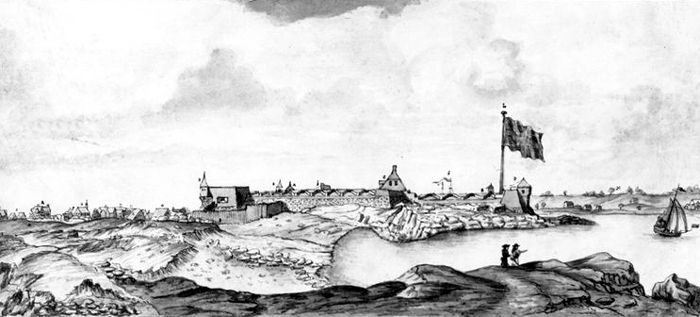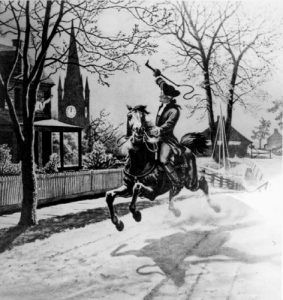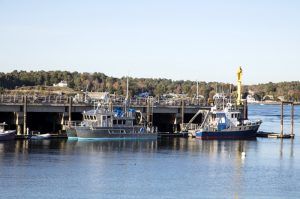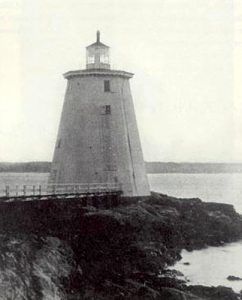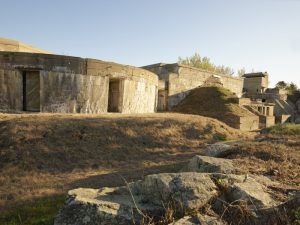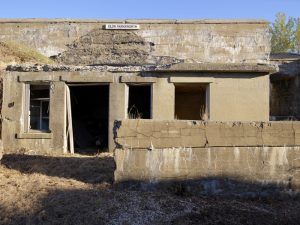
Fort Constitution, New Hampshire by Alexius Horatius, Wikipedia
Fort Constitution, New Hampshire located in New Castle overlooks the Piscataqua River and the Atlantic Ocean. Going by the names of the “The Castle”, and Fort William and Mary, before it was renamed Fort Constitution. It was first fortified sometime in 1631 and continued operations through the 1950s. Today it is a National Historic Site and New Hampshire State Park.
Located on a peninsula on the northeast corner of New Castle Island, the site was first fortified by the British in 1631. The fort was originally known as “The Castle” and guarded access to the harbor at Portsmouth and served as the colony’s main munitions depot. It also served to protect Kittery, Maine on the opposite shore, which was raided numerous times by the tribes of the Wabanaki Confederacy during the French and Indian Wars. It was manned by soldiers of the Province of New Hampshire who reported directly to the royal governor. The first installation was an earthwork fort with four large guns. A timber blockhouse was built in 1666.
The earliest forts were built to protect the colonists and The Castle was one of seven forts built to protect Portsmouth Harbor. The others included Forts Stark, Washington, and Dearborn in New Hampshire, and Forts Sullivan, McClary and Foster in Maine.
The post was renamed Fort William and Mary in about 1692, after the accession of the monarchs William III and Mary II to the British throne. By this time, stronger defenses were required and additional cannons and military supplies were sent from England and a breastwork was constructed to protect them.
The first harbor light was installed at the site, which was only a lantern hung up a flagpole, in April 1771. However, just a few months later, in July, a shingled 50-foot tall wooden lighthouse with a copper-roofed iron lantern was built and tended by soldiers at the fort. It was the first light station established at a military installation in the British colonies.
On December 13, 1774, some four months before his more famous ride on the eve of the American Revolution, Paul Revere rode from Boston, Massachusetts to warn the colonists of British plans to reinforce the fort and to protect its store of gunpowder. However, some 400 men from Portsmouth, Rye, and New Castle raided the fort and removed 16 pieces of small cannon and 98 barrels of gunpowder. They also hauled down the fort’s huge British flag. Several injuries but no deaths occurred in the engagement. Many consider the attack to be the first overt act of the Revolution. The arms and powder were distributed through several New Hampshire towns for potential use in the looming struggle against Great Britain.
British Governor John Wentworth immediately sent to Boston for help and the sloop Canceaux arrived on December 17, followed two days later by the frigate Scarborough. The latter had 40 guns and carried 100 British marines on board. This armed force prevented further raids by the Patriots but produced a dangerous state of tension.
By the summer of 1775 Governor Wentworth, with his wife and infant son took refuge in the fort and lived there for two months in hope that a conflict could be avoided. British Admiral Samuel Graves soon sent a transport to dismantle the fort and remove the guns to Boston. On August 24, 1775, the governor and his family also sailed to Boston. Britain then gave up on the colony of New Hampshire in order to focus attention on the military situation in Massachusetts and abandoned the fort.
As Portsmouth Harbor’s importance increased with the Revolutionary War, the shipbuilding industry grew and the Portsmouth Naval Shipyard was established in 1800. A new 85-foot high wooden lighthouse was constructed in 1803 about 100 yards east of the original 1771 lighthouse. Additional fortification was also needed, improvements were made to the old fort and it was renamed Fort Constitution in 1808. Renovations included a wall twice as high as that of the colonial fort and new brick buildings were constructed. The fort was then garrisoned with a company of United States artillery. It was described in 1811 as “an enclosed irregular work of masonry, mounting 36 heavy guns… (with) brick barracks for two companies…”
During the War of 1812, the fort was manned and expanded including the addition of Walbach Tower with a single 32-pounder cannon, being built in 1814.
The fort was still serviceable during the Civil War when various units were trained there. However, it needed to be replaced and construction of a new fort, which was to be a massive, three-tiered granite structure, began, but it was never completed. Construction was abandoned in 1867.
In 1877 the old wooden lighthouse was demolished and replaced with the current 48-foot high cast-iron structure of today.
In 1897 construction began on Battery Farnsworth, located under the hill on which Walbach Tower stands. The battery was completed in 1899 and included two 8-inch guns. Following the Spanish American War o 1898, the improved defense of key harbors became a national priority. Battery Hackleman, with two 3-inch guns, was built primarily to defend this minefield against minesweepers in 1904.
The fort was further rebuilt and expanded through 1899 and served actively through World War II. In 1940-1944 the Harbor Defenses of Portsmouth were garrisoned by the 22nd Coast Artillery Regiment. A mine observation station was built atop Battery Farnsworth.
Battery Hackleman was disarmed by 1948 and the fort was turned over to the Coast Guard. Afterward, Battery Hackleman was demolished. Fort Constitution was returned to the State of New Hampshire in 1961 and placed on the National Register of Historic Places on July 2, 1973.
Today, Fort Constitution occupies three acres and includes Portsmouth Harbor Light, which was built in 1878, and remains a valuable aid to navigation. The State Park is located adjacent to the U.S. Coast Guard Station at the mouth of the Piscataqua River. It is open to the public.
More Information:
Fort Constitution Historic Site
25 Wentworth Road
New Castle, New Hampshire 03854
603-271-3556
©Kathy Weiser-Alexander, updated December 2022.
Also See:
New Hampshire – The Granite State
Forts Across the United States
Forts & Presidios Photo Gallery
Sources:
Fort Constitution Historic Site
New Hampshire State Parks
North American Forts
Wikipedia

